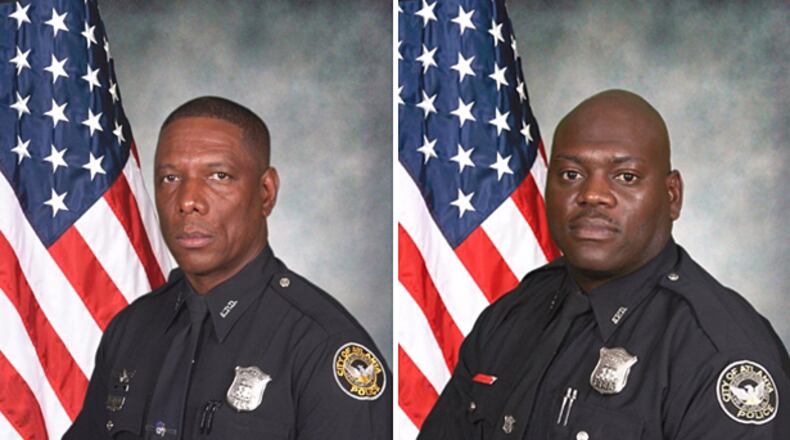Bill Riley spent many hours in the air with Atlanta police helicopter pilot Richard J. Halford.
Seven years ago, the two of them scoured the city from on high, searching for a man who had just escaped from the Fulton County Courthouse after shooting three people. On that mission and many others, Riley found Halford to be cautious, seasoned and professional.
Which is what makes it that much more puzzling that Halford died while at the controls of a helicopter that crashed in the middle of the city a week ago, killing fellow officer and passenger Shawn A. Smiley.
Riley, himself a pilot for the Fayette County Sheriff’s Office, suspects the National Transportation Safety Board investigation will find engine failure brought down the Vietnam-era helicopter. But he might not find out for sure for 12 months. In that time, NTSB investigators will meticulously reconstruct and analyze the crash, gathering information on the helicopter’s pre-impact course, weather, Halford’s activities in the days before crash and a host of other possible factors.
In the meanwhile, The Atlanta Journal-Constitution has requested some of the same records the NTSB will examine. The newspaper has also sought the opinions of pilots who have flown OH-6.
“He would not have been up there cowboying or being cavalier. He was a good stick pilot,” said Riley.
By most accounts, Halford was good at the controls and level-headed.
The Hughes OH-6 helicopter he was piloting crashed after hitting a utility poll and wires during a night search for a 9-year-old runaway.
Investigators suspect that on a night where wind or precipitation were likely not factors, Halford, 48, must have been in distress and attempting an emergency landing.
“I just believe that something had to gone wrong because this man did not fly it into a telephone pole,” said Randall Rogers, whose Quitman, Ga., business has two OH-6.
The scope of the NTSB investigation will be massive, taking in every detail, no matter how far-fetched or unrelated it may appear of “the man, the machine and the environment,”Eric Weiss. “If something can be found, it will be found.”
Questions have been raised about the fitness of this OH-6, which was built in 1967. The Army donated it to the Atlanta Police Department for the 1996 Olympics. In 2001, APD asked for it to be replaced because it and another helicopter had “outlived their useful lives of 25 years,” the department said in its request.
APD got funds for only one helicopter, so six years ago the OH-6 was overhauled.
“No reason to even focus on that thing. It’s [APD’s OH-6] been rebuilt,” Riley said.
Essentially, APD’s OH-6 was only a few years old — not 45, Riley said.
Riley and Rogers flew the OH-6 for first time when each was in combat in the Vietnam War. Riley also has been at the controls of APD’s OH-6.
“It’s probably the safest helicopter flying,” Rogers said.
That said, both men still suspect mechanical problems because of accounts from witnesses, especially one who said the helicopter was spinning, which would mean the tail rotor had failed.
“Because I’ve been flying these things for so long, the first thing I thought about was engine failure or partial power loss,” Riley said. “There was no reason to be that low, and the only reason would be in an emergency.”
Halford had been with APD 16 years and had more than 3,000 flight hours logged, and he was proficient at flying at night and routinely requested the evening watch, police commanders said. Smiley was a tactical flight officer, commonly known as a spotter, with a commercial pilot’s license.
Their flight records, their certifications and how they interacted with each other will be dissected.
“How did they cooperate? What was their experience? What was their level of training? What was their time in the cockpit?” Weiss said. “We collect all facts in all areas. Everything from [toxicology] screen to cell phone records [to] the patterns of life in last five days of the crew members.”
The NTSB investigation began the moment investigator Ralph Hicks, who is based in Atlanta, arrived at the scene moments after the crash.
Hicks used a Georgia Power Co. bucket truck to examine the crash from the air and then for a close look at the utility pole where the helicopter hit.
Weiss said cameras, lasers, high-tech measuring devices, GPS plotters and a three-D digital scanner was used to map the wreckage before it was removed and taken to a hangar where it will be dismantled.
In the next few weeks and months, Weiss said, the investigation will call experts from various fields as well as from the companies that built the helicopter and the new engine.
Engineers from Boeing will be part of the investigation; Boeing merged with McDonnell Douglas after it took over Hughes Aircraft, which designed the OH-6. Rolls Royce built the engine.
But, Riley noted, if may be difficult to determine if there was engine failure. “The way it burned, it will be hard to [determine] an absolute cause,” he said.
Investigators will review maintenance and service records from as far back as the first owner, the military.
Weiss said precise weather conditions will be documented. The 911 calls will be reviewed. Witnesses will be interviewed. And investigators will retrieve any photographs they may have taken.
“We go in with zero assumptions,” Weiss said. “We collect all facts in all areas. We do not rule anything out.”
About the Author
The Latest
Featured


